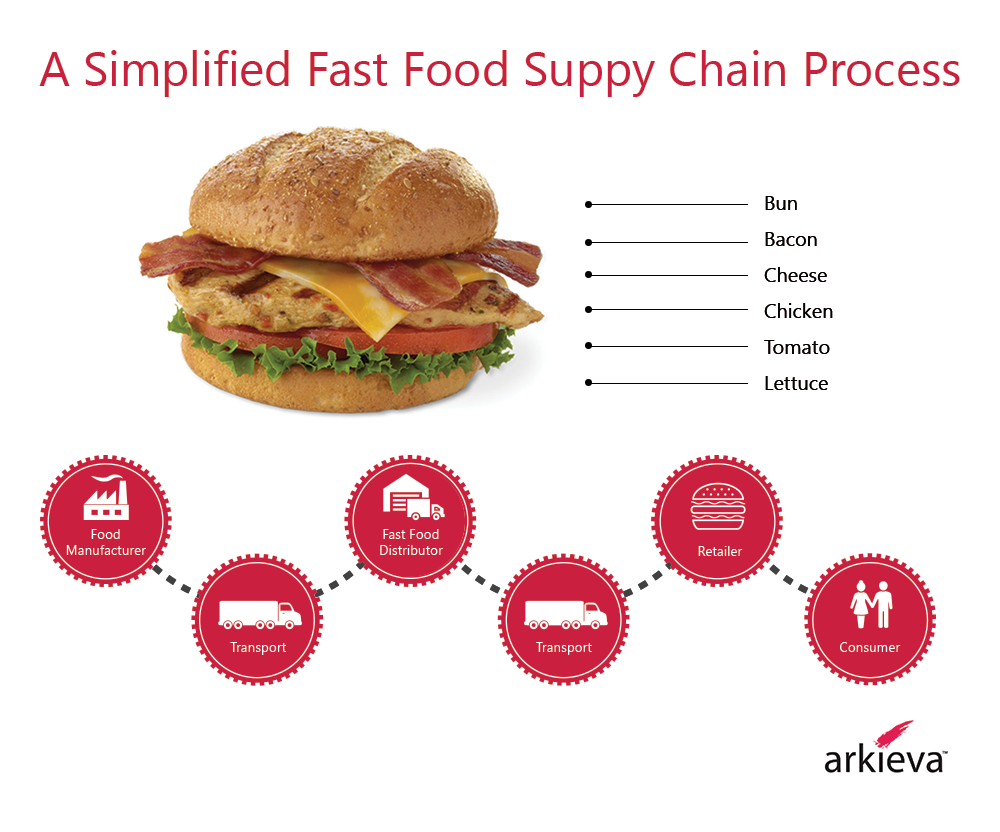
Fast food restaurants have now become an American staple. It’s nearly impossible in most areas to go about a 5-mile radius without running into a fast-food restaurant. In fact, it’s estimated that there are over 240,000 fast food restaurant establishments in the United States.
Now and then, we hear about horrific fast food restaurant stories where an “unwanted extra ingredient” is found. This includes the recent story about the woman who found a mouse baked in her sandwich bun, as well as someone else who found a worm. While we may be quick to blame the serving fast food restaurant for the mishap, the supply chain of fast foods is often complicated. When we stop by our favorite fast food restaurant to grab a quick bite, we often don’t think about the process that goes into assembling our combo meal. For instance, my favorite grilled chicken sandwich from Chick-fil-a is made with the following ingredients: a bun, grilled chicken breasts, lettuce, onion, tomato, bacon, and a slice of Colby Jack cheese. Due to the number of ingredients involved Chick-fil-a just like most fast food restaurants have a complicated supply chain due to the number of suppliers that they have to manage. When supplier relationship management is coupled with changing consumer demands, the supply chain for fast foods naturally has added layers of complexity.
What does the Supply Chain of a Typical Fast Food Look Like?
Going back to my previous example, my grilled sandwich has various ingredients. Due to this, the typical supply chain for creating the bun could look something like this: farm → food manufacturer → distribution center → retailer (fast food restaurant) → customer. This sample supply chain is shown in more detail using the illustration below.

As you notice from the illustration above, there are multiple steps in the process, therefore making it difficult for the fast food restaurant to always keep a keen eye on the entire network. From a consumer’s perspective, the burden of producing a quality meal often rests on the end retailer or fast food restaurant. However, to ensure that the quality requirement is met, all suppliers involved in the supply chain network need to adhere to same quality assurance standards.
So, who’s to blame for the baked mouse in a bun?
Is it the food manufacturer? Or the fast food restaurant that failed to notice the “unwanted ingredient?” Perhaps, they should all share the blame. With that said, because the food manufacturer is upstream in the supply chain, and probably doesn’t deal directly with customers, we are likely to associate any mishap with the fast food retailer. Quality control may be one of the more visible concerns with the supply chain of fast foods. The are other sometimes not so visible challenges that the typical fast food retailer must overcome.
[Read more: Establishing a Proactive Supply Chain Using Early Warning Indicators]Here are some of the main supply chain challenges that fast food establishments face today
1. Difficulty in Fulfilling Consumer Transparency Demands
Consumers today don’t just want to read a label saying that their burger is 100% Angus beef. They want proof that it’s truly the case. As a result, many fast food chains have embarked on various transparency campaigns explaining their food creation process in more detail.
Think about Wendy’s commercial on how their meat isn’t frozen.
Consumers want detailed information on how their food is handled right from the farm until when they make their Big Mac purchase. It may seem like an unrealistic expectation but studies show that consumers are more likely to trust a brand, the more transparent they are with their manufacturing, distribution, or supply chain network practices. This increasing demand adds another layer of complexity and sometimes additional costs. For the fast food retailer interested in gaining total control over the entire network, one possible solution would be to go into the supplier businesses themselves so that they can manufacturer their ingredients. Another possible solution would be to have systems that allow for more visibility through the supply chain process from upstream to downstream.
2. Creating a Truly Standardized Supply Chain May be a Wishlist Item
Creating a standardized process especially for franchised fast food operations gets a little tricky. You’ve probably experienced a situation where one fast food restaurant location from the same chain tastes a little better the other. This is because while all franchise businesses try to operate under one umbrella of quality standards, what happens in the actual fast food establishment is often up to the management in that physical location. I had a friend who worked for a major fast food chain who complained to me about how they tried to save money by using the same oil more than three times. The standard operational practice for the fast food chain was to switch the oil after three usages. Additionally, fries and meat were not to be fried using the same oil. According to the story, this restaurant chain location ignored these practices to cut on oil costs and increase bottom line results. Standardization in fast food establishments can be difficult to implement when aiming at ensuring the same quality and service levels every time.
3. Inventory Management for Items with Low Shelf Life
Most fast food restaurants deal with food ingredients that have a low shelf life. As a result, suppliers need to ensure that deliveries are on-time and at the right freshness and quality level. If it takes a tomato about five days to go bad; if deliveries are not just-in-time or as needed, they may end up with ingredients that go to waste as a result of spoilage. Additionally, fast food purchases are considered on-demand orders. Meaning, you think to yourself, “I’d like to have a burger today!” then, you drive to the nearest fast food location in hopes of buying yourself a burger. There is often no pre-planning or even lead time. Fast food restaurants forecasting methods may be bogged down to lose estimations based on history. They always have to play a delicate balancing act of ensuring that they stock enough ingredients but not too much that it goes to waste before it can be used.
4. Limited Time Offers Requires Robust Promotion Planning
Ever wondered how fast food restaurants decide when to add a new menu item? Think about those limited time offers. Before most fast food chains decide to add a new menu item, they often test it out with a few selected locations and promote the product as a limited time offer. The psychology behind something that’s new and limited often causes a spike in sales for that product. Most chains, however, track these purchases and use a historical analysis to determine if the item is something that should be added to the menu. For this process to go smoothly, there is a need for robust promotion planning analysis and product management, which includes inventory management and capacity planning. Fast food restaurants also, have to look at the bigger picture when launching new products. The introduction of a new product that is doing well may be cause for pulling a more obsolete or low sales item off the menu.
5. Difficulty in Tracking and Responding to Demand Signals in Real-Time
The Fast food industry is highly saturated and a fiercely competitive market. For fast food establishments to be successful, they need to employ different methods for tracking demand signals in the market place. This presents a pull approach to demand management. Essentially, the basic concept is if you give customers the products that they want, then you don’t have “push” products that you want to sell to them. They will naturally demand the products because they already match with their needs. In the fast food industry, consumer demand often evolves with time. There was a time when fast food restaurants didn’t have other healthier options such as salads. Today, due to the increase in more health-conscious consumers, most fast food restaurants now have healthier menu items to serve a demographic that may go elsewhere.
[Read more: 5 Things to Know About Setting Up a Better Supply Chain Performance Measurement System]So, the next time you take a juicy bite out of a burger from a fast food restaurant, it might be interesting to take a moment to think about the entire supply chain process to satisfy your craving.
Enjoyed this post? Subscribe or follow Arkieva on Linkedin, Twitter, and Facebook for blog updates.





